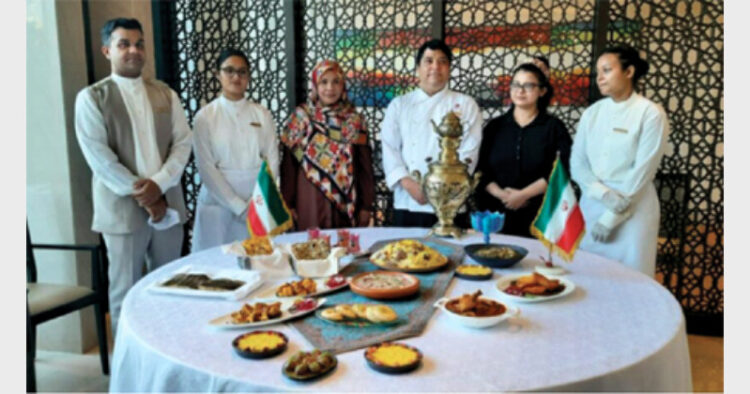As the international media is focusing on the civilisational leap made by Bharat as the highly revered Hindu place of worship – the Kashi Vishwanath Temple was given a new look and inaugurated with fanfare by Prime Minister Narendra Modi, it also needs to put the spotlight on a lesser known Hindu Temple in the port city of Bandar Abbas in Iran. This temple has an imprint of Hindu deity Vishnu as well as motifs like nashkashi celebrating the richness and uniqueness of Iran’s cultural heritage.
Built during the reign of Mohammad Hassan Khan Sa'd-ol-Malek, erstwhile ruler of Bandar Abbas, this temple could never have seen light of the day had not Hindu merchants voluntarily made financial grants for its construction. Indeed, it’s inspired by India’s dazzling architecture. In fact, the architectural style of the contour of its dome distinguishes it from other Persian heritage buildings.
This age-old link between the two countries was explained at a special curtain raiser to a food event organised by the Cultural Councilor of Iran in India, Dr. Mohd Ali Rabbani in New Delhi recently.
Pointing out that Iranian cuisine has a deep connection with India, Dr Rabbani said during the reign of Mughal emperor Humayun, Iranian food was given a fillip. “The relations between the two countries are very old. There is evidence that Humayun had a fondness for Iranian food. If we can revive those dishes then it would create a strong cultural bond,” said Dr Rabbani.
Elaborating on how the Mughal emperors have been patronising dishes from her country, Chef Mona Nezhad says the concept of kebabs first came when the first Mughal emperor Babur set foot on India and established his kingdom there. Some of this is reflected in the kind of food eaten in India like vegetarian kebabs and seekh kebabs cooked on skewers or sweets like Balushai and phirni. However, people by and large are ignorant of this fact. “I have watched sweetmeat shop owners sprinkling salt in mithai. This is similar to what we do at home. Then dishes like korma, biryani, sheerkhand (kheer) have all come from our country,” informed the Chef.
Interestingly, the link between Bharat and this West Asian country is not surprising as Indian and Iranian traders have been travelling from Bandar Abbas that enjoys a strategic position as it lies on the southern coast of Iran to Bombay for trade in spices like black pepper and cardamom.
Food Ties between Bombay and Bandar Abbas
Apart from the Mughals, the enterprising traders of both countries were instrumental in strengthening the food link. The cultural exchanges between Bombay and Bandar Abbas through the sea route gave foodies in Southern Iran a chance to experiment when it comes to tweaking their cuisine.
Due to the arrival of spices from Bharat, Iranian dishes in the coastal side were spiced up and had more chillies than their counterparts in the North. This continues till this day.
ISKCON in TehranIndian connection is visible in a vegetarian restaurant run by International Society of Krishna Consciousness (ISKCON) in Tehran. It has been in existence since 1977. One year later, Swami Prabhupada, founder of ISKCON, was in Tehran |
Iranian food hasn’t flourished in India as it is generally seen as bland by food lovers. It is minimally spiced like Mediterranean cuisine. While Italian food is much sought after, foodies in Delhi have been giving Iranian food a miss. Most Indians who like their dishes extra hot do not care to tuck into healthy food options preferred in Tehran. Iranian food has distinct flavours as well as healthy dry fruits in its dishes. However, Iranian cuisine, despite the opening of Iranian food like the Soda Bottle Opener Wala at Khan Market, haven’t been able to make inroads into eateries of Delhi.
Fostering Cultural Bonhomie
Due to this fact, the Iranian Embassy roped in a celebrity from erstwhile Persia who can best represent the best of old and new Iranian traditions and culture. So came celebrated chef Mona Nezhad, who has been making frequent visits to India for the past decade. Her familiarity with India as well as her experience in hosting food festivals in Jammu, Hyderabad and other Indian cities made her the favourite choice of Iranian Cultural Head.
Chef Mona Nezhad gave cooking lessons to Gagandeep Singh Sawhney, Executive Chef at Shangri-La Hotel in Connaught Place where Dawat-E-Iran, a buffet, was organised for diplomats and businessmen from December 16 to 19. The special delicacies were cooked under the supervision of Iranian Chef Mona Nezhad.
Iranian food hasn’t flourished in India as it is generally seen as bland by food lovers. It is minimally spiced like Mediterranean cuisine. While Italian food is much sought after, foodies in Delhi have been giving Iranian food a miss
The Chef, known for cooking for the royals, confided that she brought with her saffron and other exotic spices to give an Iranian flavour to the food fest.
After its conclusion, the dishes would perhaps be added on the menu of the five star hotel or other eateries in Deli so that the public can enjoy a hearty and healthy Iranian meal.
Thanks to Chef Mona Nezhad, food lovers in Delhi know how to make and present baingan (brinjal) in the best possible way. “Many Iranians are veggies; so vegetarians who are keen to try cuisines of West Asia but do not touch them for fear of eating meat or egg, can try some dishes made of eggplants and desserts like different variant of Bakhawa and other sweet dishes that are tasty and nutritious, says Chef.
This festival could not have been possible without special interest taken by Dr Mohammad Ali Rabbani, Cultural Counsellor, Embassy of Iran and Head of Iran Cultural House, New Delhi.














Comments